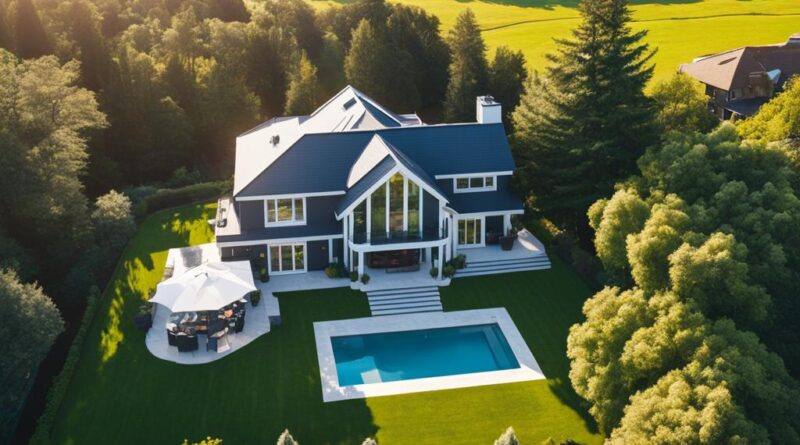Mastering Real Estate Videography for Sales
In today’s competitive real estate market, mastering the art of real estate videography is essential for agents and sellers looking to attract and captivate potential buyers. With the rise of online property searches and virtual tours, high-quality video content has become a powerful tool for showcasing properties and driving sales. In this article, we will guide you through the process of creating professional real estate videos, from understanding camera settings to shooting techniques and post-production editing.
Key Takeaways:
- Real estate videography is a crucial tool in the competitive real estate market.
- Creating high-quality video content can attract and captivate potential buyers.
- Understanding camera settings and shooting techniques is essential for producing compelling real estate videos.
- Post-production editing enhances the visual appeal of real estate videos.
- Real estate video marketing offers numerous benefits for agents and sellers.
Understanding Camera Settings for Real Estate Videography
Before diving into real estate videography, it’s crucial to have a solid understanding of the basic camera settings. These settings play a crucial role in determining the overall quality and look of your real estate videos. Let’s explore the key camera settings that you need to consider:
Resolution:
The resolution refers to the number of pixels in each frame of your video. Higher resolution means more detail and clarity in your footage. It’s recommended to capture real estate videos in the highest resolution possible to showcase the property’s features accurately.
White Balance:
White balance ensures that the colors in your video appear natural and accurate. Adjusting the white balance setting based on the lighting conditions is crucial to avoid unnatural color casts.
Frame Rate:
The frame rate determines the number of frames per second (fps) in your video. Higher frame rates result in smoother motion, while lower frame rates create a more cinematic effect. Consider the intended purpose of your video when selecting the frame rate.
Shutter Speed:
The shutter speed refers to the length of time the camera’s shutter remains open. It impacts the exposure and motion blur in your footage. Set an appropriate shutter speed to maintain the desired exposure and avoid blurry shots.
ISO:
ISO controls the camera’s sensitivity to light. Higher ISO settings are suitable for low-light conditions, but they can introduce noise or grain in your footage. Adjust the ISO to balance brightness and image quality.
Aperture:
The aperture determines the amount of light that enters the lens. It impacts the depth of field, allowing you to control what is in focus. Consider using smaller apertures to capture more of the property in focus or larger apertures to create a shallow depth of field for a more artistic look.
Picture Profile:
The picture profile setting adjusts the overall look and style of your footage. Experiment with different picture profiles to achieve the desired mood or aesthetic for your real estate videos.
Understanding these camera settings will empower you to capture stunning real estate videos that highlight the property’s best features. Now, let’s move on to the next section and explore the pre-shooting preparation for real estate videos.
Pre-Shooting Preparation for Real Estate Videos
Before starting a real estate video shoot, proper pre-shooting preparation is crucial to ensure a successful outcome. By taking the time to communicate with your clients, understand their preferences, and gather knowledge about the property and its surroundings, you can create videos that effectively highlight its unique features and appeal to potential buyers.
One essential step in pre-shooting preparation is having a discussion with your clients to understand their specific preferences. Every property has its own unique selling points, and it’s important to know which features your clients want to showcase. This could include anything from beautiful architecture and stunning interior design to spacious backyard areas or high-end appliances.
In addition to client preferences, it’s also vital to familiarize yourself with the neighborhood where the property is located. Having knowledge about nearby amenities and attractions can greatly enhance the video’s appeal. For example, if there are popular restaurants or shopping centers in the area, mentioning them in the video can add value to the property and attract potential buyers.
By preparing thoroughly before the shoot, you can ensure that your real estate videos effectively capture the essence of the property and its surroundings. This attention to detail not only impresses clients but also engages potential buyers, increasing the chances of a successful sale.
Shooting Techniques for Real Estate Videography
To capture compelling footage for real estate videos, mastering effective shooting techniques is essential. By employing the right approach, you can enhance the visual appeal of the property and engage potential buyers. In this section, we’ll explore key shooting techniques that can elevate your real estate videography game.
Capturing Multiple Angles
When shooting real estate videos, it’s crucial to showcase different perspectives of each room. By capturing multiple angles, you can provide viewers with a comprehensive view of the space. This allows potential buyers to get a better sense of the property’s layout, highlighting its unique features and potential.
Emphasizing Spaciousness
One effective technique to enhance the perceived spaciousness of a property is by utilizing corner shots. By positioning yourself in the corners of each room, you can create a visual effect that makes the space appear larger and more inviting. This technique helps potential buyers envision themselves in the property and enhances their overall impression.
Highlighting Exterior Shots
While showcasing the interior is important, don’t forget to capture exterior shots as well. Exterior shots allow potential buyers to see the property’s surroundings, including the neighborhood, outdoor amenities, and landscaping. This helps create a well-rounded impression and provides a sense of the property’s overall appeal.
Utilizing Drone Footage
Drone footage is an excellent tool to showcase the property from a bird’s-eye view. By capturing aerial shots, you can provide a unique perspective that highlights the property’s location, proximity to landmarks, and nearby amenities. Drone footage adds a wow factor to your real estate videos and captures the attention of prospective buyers.
| Shooting Technique | Description |
|---|---|
| Capturing Multiple Angles | Showcasing different perspectives of each room to provide a comprehensive view of the property. |
| Emphasizing Spaciousness | Using corner shots to create a visual effect that enhances the perceived spaciousness of the property. |
| Highlighting Exterior Shots | Capturing shots of the property’s surroundings, including the neighborhood and outdoor features. |
| Utilizing Drone Footage | Capturing aerial shots to showcase the property from a bird’s-eye view and highlight its location. |
By implementing these shooting techniques in your real estate videography, you can create visually engaging videos that captivate potential buyers and showcase the property’s best features.
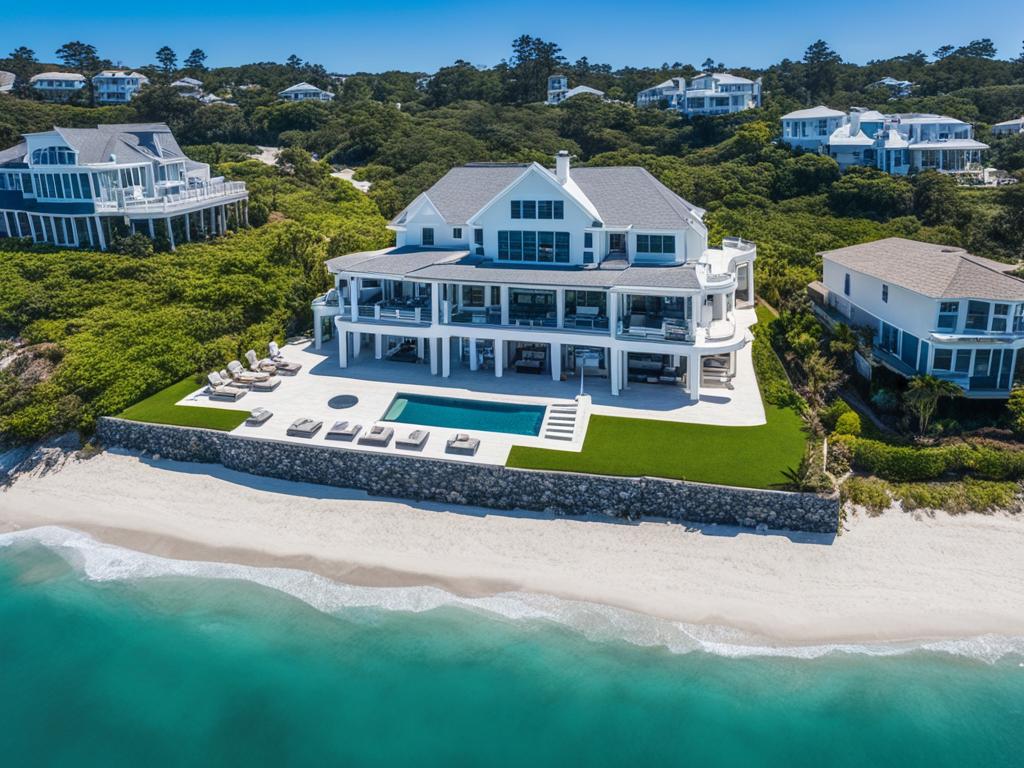
Post-Production Editing for Real Estate Videos
Once you’ve completed the shooting phase of your real estate videos, it’s time to move on to the post-production editing process. This critical step is where your raw footage is transformed into polished and engaging final products that capture the attention of potential buyers. By utilizing various editing techniques, you can enhance the visual appeal of your real estate videos and create a compelling viewing experience.
Video Selection
The first step in post-production editing is selecting the best video clips to include in your final real estate video. Review all your footage and choose the shots that highlight the property’s unique features and showcase its full potential. By carefully curating the video content, you ensure that your final product is concise and impactful, capturing the attention of viewers from start to finish.
Lighting Adjustments
During the shooting process, it’s common for lighting conditions to vary from one shot to another. In post-production, you can make lighting adjustments to ensure consistent lighting throughout the video. This involves adjusting the brightness, contrast, and exposure of each clip to create a visually pleasing and well-balanced final result.
Color Correction
Color correction is another essential step in post-production editing for real estate videos. It involves adjusting the colors and tones of each clip to enhance their overall appearance. By fine-tuning the color balance, saturation, and vibrancy, you can create a visually appealing video that accurately represents the property’s aesthetic appeal.
Noise Removal
In some cases, real estate videos may have unwanted background noise or audio imperfections. To ensure a professional and polished final product, it’s important to remove any distracting noise. Utilize audio editing tools to reduce or eliminate background noise, ensuring that the focus remains on the property and its features.
Music Embedding
Adding background music to your real estate videos can greatly enhance the viewing experience. Select a soundtrack that complements the property’s atmosphere and use music embedding techniques to seamlessly integrate it into the video. The right music can create an emotional connection with viewers and help set the tone for the video.
By investing time and effort into post-production editing, you can transform your raw footage into captivating real estate videos that leave a lasting impression on potential buyers. Through video selection, lighting adjustments, color correction, noise removal, and music embedding, you can create visually appealing and engaging videos that effectively highlight the property’s unique features.
| Editing Techniques | Description |
|---|---|
| Video Selection | Select the best clips to include in the final video, showcasing the property’s unique features. |
| Lighting Adjustments | Ensure consistent lighting throughout the video by adjusting brightness, contrast, and exposure. |
| Color Correction | Adjust the colors and tones of each clip to enhance their overall appearance and create visual appeal. |
| Noise Removal | Remove unwanted background noise or audio imperfections to maintain a professional and polished final product. |
| Music Embedding | Add background music that complements the property’s atmosphere and seamlessly integrate it into the video. |
Benefits of Real Estate Video Marketing
Real estate video marketing offers numerous benefits for agents and sellers. By utilizing videos in property listings, agents can enhance buyer engagement and increase their online presence. Real estate videos provide an immersive experience for potential buyers, allowing them to virtually tour properties and get a better sense of each space. This can lead to increased exposure and ultimately attract more potential buyers.
When it comes to property listings, photos alone may not effectively capture the essence and appeal of a property. Real estate videos, on the other hand, enable agents to showcase the property in a dynamic and engaging way. Videos allow potential buyers to visualize themselves in the space, experiencing the layout, flow, and ambiance of the property.
Buyer engagement is a crucial aspect of real estate marketing, and videos have proven to be highly effective in this regard. Studies have shown that properties with video tours receive more inquiries and have a higher conversion rate than those without. This is because videos create a stronger emotional connection with viewers, making them more likely to take action and contact the agent for further information or to schedule a viewing.
Real estate videos provide an immersive experience for potential buyers, allowing them to virtually tour properties and get a better sense of each space.
Furthermore, incorporating videos into property listings enhances the online presence of agents and sellers. With the increasing number of online platforms for property listings, it’s essential to stand out from the competition. Real estate videos not only attract more views but also increase the time potential buyers spend on the listing. This improved engagement signals to search engines and online platforms that the listing is relevant and valuable, potentially boosting its visibility in search results and increasing exposure to a larger audience.
Virtual tours have become especially relevant in the current era, where distance and travel restrictions may limit in-person property visits. Real estate videos offer a convenient and safe way for potential buyers to explore properties remotely, providing them with a comprehensive understanding of the property’s layout, features, and overall appeal. This can save time for both buyers and agents, as it helps filter out less interested parties and encourages serious inquiries.
Overall, real estate video marketing is a powerful tool that can significantly impact the success of property listings. By utilizing videos, agents and sellers can enhance buyer engagement, increase online presence, and provide potential buyers with an immersive experience that goes beyond static images. Incorporating real estate videos into marketing strategies can lead to increased exposure, greater buyer interest, and ultimately, better sales outcomes.
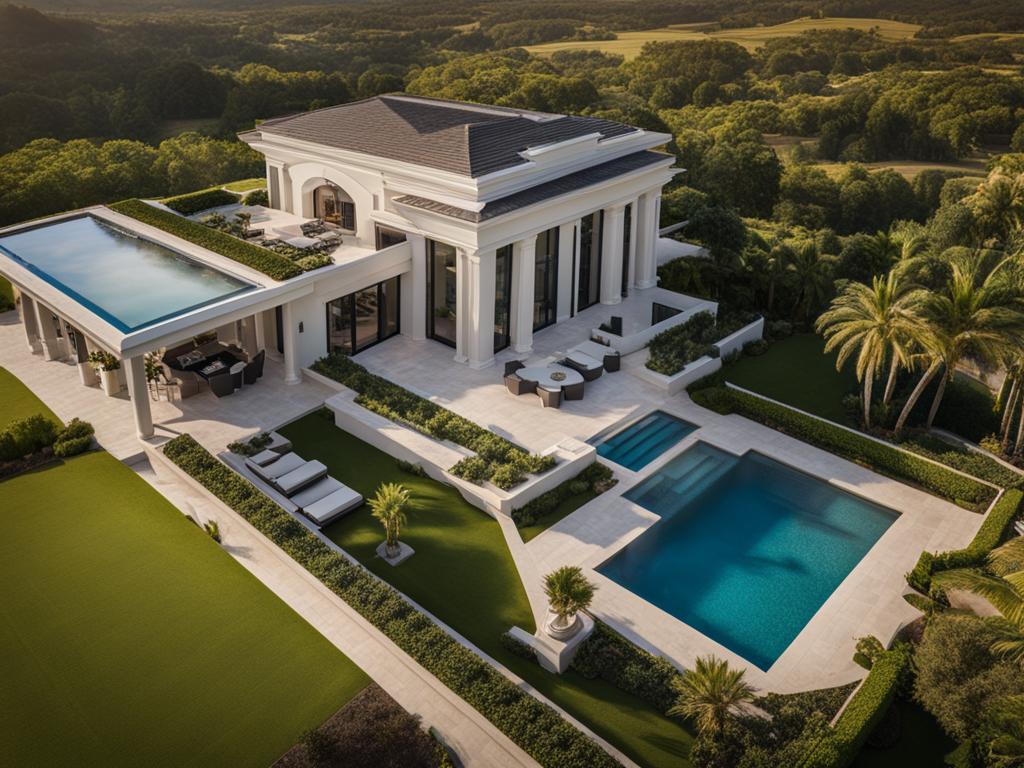
Real Estate Videography Pricing
When considering real estate videography, it’s essential to have a clear understanding of the associated costs. The pricing for real estate videography can vary depending on factors such as the value of the property and the expertise of the videographer. It’s important to assess the potential return on investment and the value that high-quality real estate videos can bring to a listing.
Professional videographers who specialize in real estate may charge anywhere from $500 to $2,500 for a single video shoot. The price range depends on the complexity of the project, including the size and features of the property, the duration of the video, and any additional services required. Higher-end properties or luxury listings may command a higher price tag, as capturing the essence and appeal of these properties requires extra attention to detail.
Keep in mind that the cost of real estate videography should be viewed as an investment rather than an expense. High-quality videos have the potential to attract a larger pool of potential buyers and generate more interest in a property. A visually stunning and engaging real estate video can make a listing stand out from the competition and increase the chances of a successful sale.
Before finalizing a budget for real estate videography, it’s crucial to consider the reputation and track record of the videographer. Experienced professionals who have established themselves in the industry may charge higher fees due to their expertise and portfolio. However, their skills and expertise can significantly enhance the overall quality and impact of the video, ultimately benefiting the seller.
While it’s important to strike a balance between cost and quality, it’s recommended not to compromise on the quality of the videography to save on costs. A poorly executed video can have a negative impact on the perception of a property and deter potential buyers.
When comparing prices and videographers, it’s also important to review their previous work and consider the level of customer service and attention to detail they provide. A professional videographer who understands the unique selling points of a property and can effectively capture its essence will be worth the investment.
Real Estate Videography Pricing Comparison
| Videographer | Price Range | Additional Services | Portfolio Examples |
|---|---|---|---|
| ABC Videography | $500 – $1,000 | Drone footage, virtual tours | |
| XYZ Productions | $1,000 – $2,500 | 360-degree videos, property website integration | |
| PQR Studios | $800 – $1,500 | Video editing, voiceover narration |
As seen in the pricing comparison table above, different videographers offer varying price ranges for real estate videography services. It’s crucial to assess the specific needs of a property listing and determine the appropriate budget accordingly. Investing in professional real estate videography can lead to a higher level of buyer engagement, increased exposure, and ultimately, a smoother and more successful sales process.
Best Cameras for Real Estate Videography
The choice of camera for real estate videography can greatly impact the quality of the footage. When it comes to capturing stunning real estate videos, there are several top camera models that deliver exceptional results.
Canon EOS 1D X Mark
Featuring a full-frame sensor, the Canon EOS 1D X Mark offers excellent image quality and low-light performance. Its advanced autofocus system ensures sharp focus, even in challenging shooting conditions. With its robust build quality and professional-grade video capabilities, this camera is a popular choice among real estate videographers.
Sony Alpha
The Sony Alpha series, such as the Sony Alpha A7 III, offers great versatility and image quality. These mirrorless cameras provide high-resolution video recording, superb dynamic range, and excellent low-light performance. With its advanced autofocus system and ability to capture stunning details, the Sony Alpha series is highly recommended for real estate videography.
Panasonic Lumix FZ80
The Panasonic Lumix FZ80 is an affordable option that doesn’t compromise on performance. This compact superzoom camera boasts a 60x zoom lens, allowing you to capture wide-angle shots as well as close-ups of architectural details. It also features 4K video recording and a variety of useful shooting modes, making it a reliable choice for real estate videography on a budget.
When choosing a camera for real estate videography, it’s important to consider factors such as image quality, low-light performance, autofocus capabilities, and video resolution. Each of these camera models offers unique features and benefits, ensuring stunning footage that showcases the beauty and details of properties.
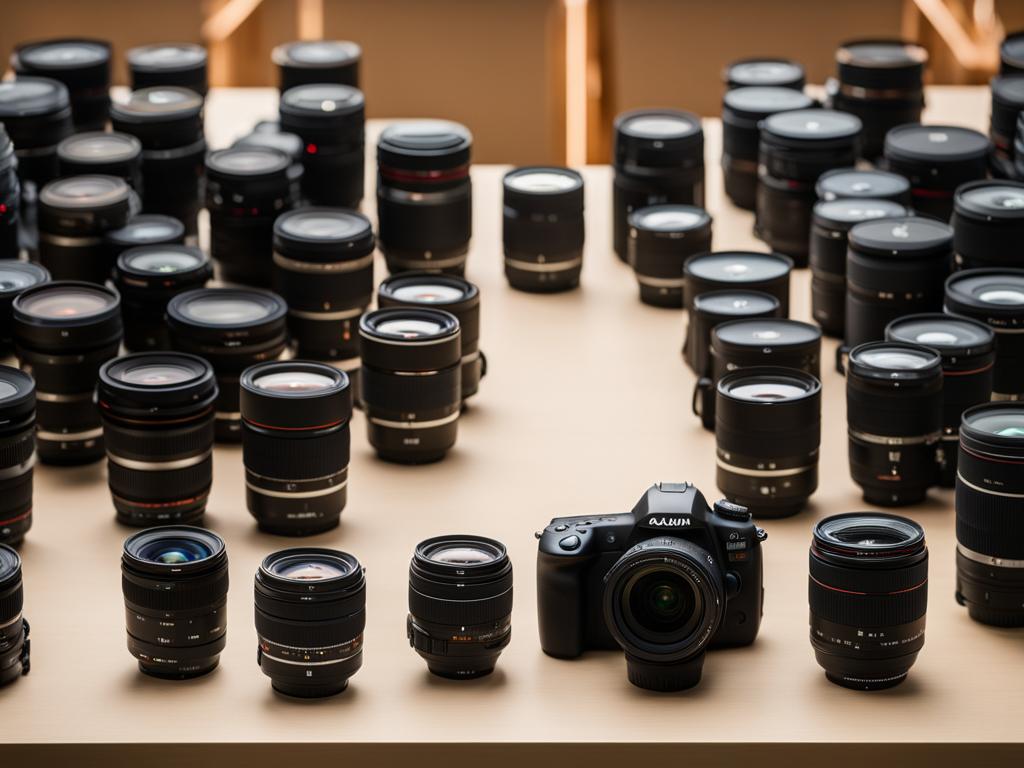
With the right camera in hand, you’ll be well-equipped to capture captivating real estate videos that attract potential buyers and showcase properties in the best light.
Shooting Real Estate Videos in Different Weather Conditions
While shooting real estate videos in ideal weather conditions is generally preferred, there may be situations where filming in cloudy or rainy weather can be advantageous. Depending on the property and the client’s preferences, shooting in these conditions can add a unique atmosphere and highlight certain features of the property. However, it’s important to ensure the quality of the video is not compromised due to adverse weather conditions.
Cloudy weather can create a soft and diffused light, which can be beneficial when showcasing interior spaces. The absence of harsh sunlight can help minimize glare, creating a more even and balanced exposure. Additionally, cloudy skies can provide a calm and serene ambiance, ideal for emphasizing the cozy and intimate aspects of a property.
On the other hand, rainy weather presents an opportunity to showcase the resilience and durability of a property. The presence of raindrops can add texture and movement to exterior shots, creating a visually dynamic and engaging video. Furthermore, rainy weather can evoke a sense of warmth and comfort, appealing to potential buyers who appreciate the cozy feeling of being indoors during inclement weather.
When shooting in cloudy or rainy weather, it’s crucial to make the necessary adjustments to ensure the video quality remains high. Consider using appropriate camera settings, such as adjusting the white balance to compensate for the cool tones associated with cloudy weather or increasing the shutter speed to capture the movement of raindrops in a way that appears natural and appealing.
Overall, shooting real estate videos in different weather conditions can offer unique opportunities to create visually captivating content. By carefully considering the property, client preferences, and making the necessary adjustments, real estate videographers can capture the essence of a property’s charm even in less-than-ideal weather conditions.
Best Real Estate Video Courses for Learning Videography
If you’re looking to enhance your real estate videography skills, there are several online courses available that can provide valuable education and training. These courses cover various aspects of real estate videography, from camera techniques to editing and marketing strategies. By enrolling in these courses, you can develop the necessary skills to create compelling and professional-quality real estate videos.
Recommended Real Estate Video Courses
-
Real Estate Video Pro by Full Time Filmmaker
Key Features: This immersive video course created by Full Time Filmmaker offers in-depth training on real estate videography. You’ll learn essential camera techniques, effective shooting strategies, and advanced editing skills. The course also covers marketing tips to help you showcase your work and attract clients.
-
Tomorrow’s Filmmakers
Key Features: Tomorrow’s Filmmakers provides a comprehensive video course specifically designed for aspiring real estate videographers. The course covers camera settings, framing techniques, lighting, and post-production editing. Additionally, you’ll gain insights into marketing strategies to effectively promote your real estate video services.
-
Skillshare
Key Features: Skillshare offers a wide range of real estate videography courses taught by industry professionals. These courses cover various topics, including camera equipment selection, shooting techniques, editing software tutorials, and marketing strategies. With Skillshare’s extensive library, you can access a variety of educational videos to enhance your real estate videography skills.
By enrolling in these real estate video courses, you can gain valuable knowledge and practical skills to create professional-quality videos that effectively showcase properties, attract potential buyers, and elevate your real estate videography career.
| Real Estate Video Course | Key Features |
|---|---|
| Real Estate Video Pro by Full Time Filmmaker | In-depth training on camera techniques, shooting strategies, and advanced editing skills. Marketing tips for showcasing your work and attracting clients. |
| Tomorrow’s Filmmakers | Comprehensive course covering camera settings, framing techniques, lighting, post-production editing, and marketing strategies. |
| Skillshare | A wide range of courses taught by industry professionals, covering camera equipment selection, shooting techniques, editing software tutorials, and marketing strategies. |
With these recommended real estate video courses, you can enhance your videography skills and stay ahead in the competitive real estate market.
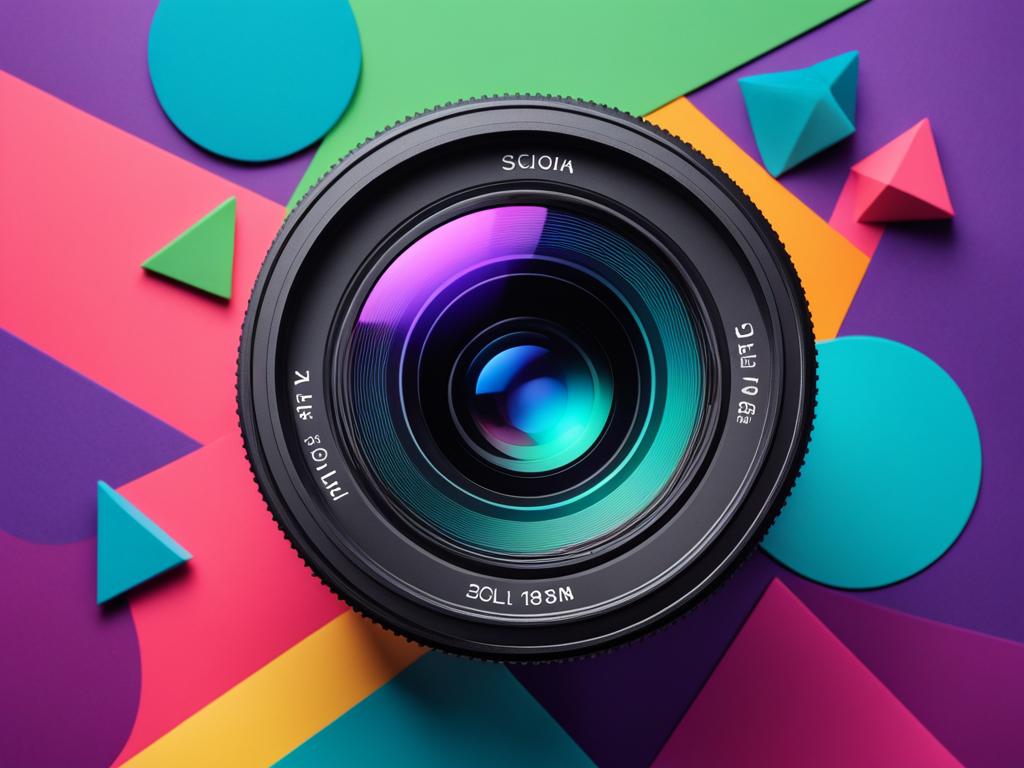
Examples of Effective Real Estate Video Types
Real estate agents can leverage the power of videos to generate and nurture leads effectively. By creating various types of videos, agents can engage potential buyers and establish trust and credibility. Here are some examples of real estate videos that have proven to be highly effective:
Educational Videos
Educational videos provide valuable information to potential buyers, helping them make informed decisions. These videos can cover topics such as understanding the buying process, tips for first-time homebuyers, and financial considerations when purchasing a property. By offering educational content, agents position themselves as knowledgeable resources and build trust with their audience.
Listing Walk-Through Videos
Listing walk-through videos are a powerful tool for showcasing the best features of a property. By providing a virtual tour of the property, agents can give potential buyers a realistic sense of the space without them physically visiting the property. These videos allow viewers to experience the flow of the house, its overall layout, and the quality of finishes and amenities.
Agent Introduction Videos
Agent introduction videos serve as a personalized introduction to real estate agents. These videos help agents establish a connection with potential clients by sharing their background, experience, and areas of expertise. By putting a face to the name, agents can build trust and differentiate themselves from competitors.
Client Testimonial Videos
Client testimonial videos feature satisfied buyers sharing their positive experiences working with a particular agent. These testimonials serve as social proof and demonstrate the agent’s ability to deliver excellent service. By featuring authentic testimonials, agents can build credibility and attract potential buyers who resonate with the positive experiences shared by others.
Each video type serves a unique purpose in a comprehensive real estate marketing strategy. Agents can strategically utilize these videos to engage their audience, showcase properties, and build strong relationships with potential buyers.
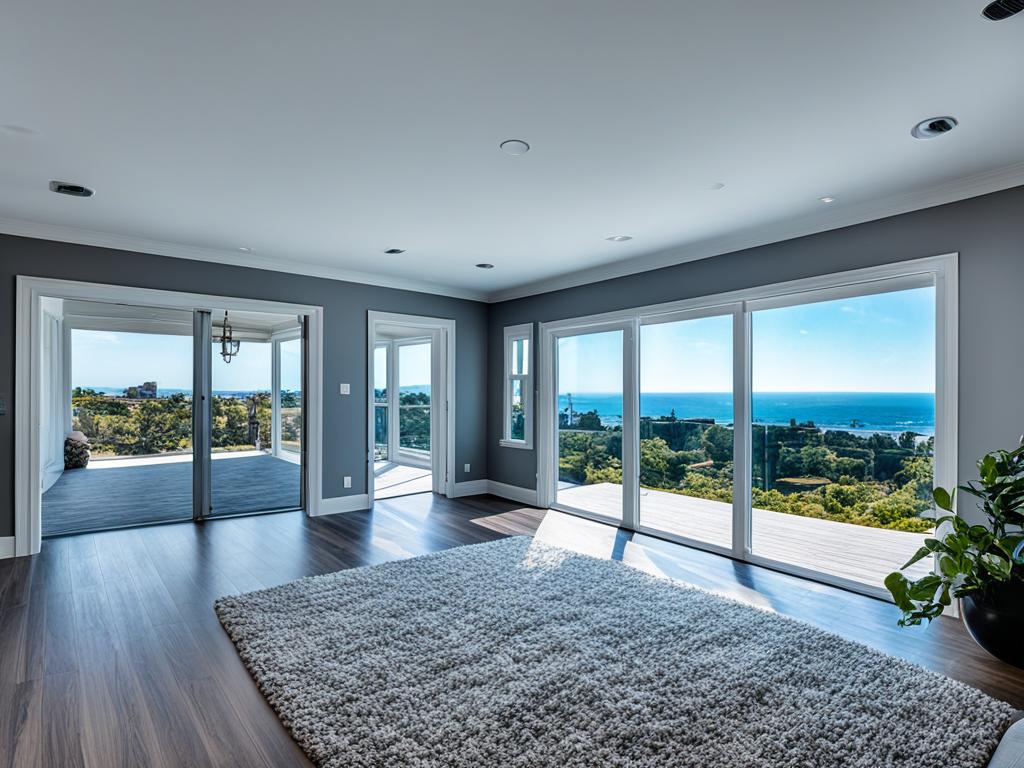
Tips for Creating Irresistible Real Estate Videos
When it comes to real estate videography, there are several tips you can follow to create captivating and irresistible videos that grab the attention of potential buyers. These tips will ensure that your videos stand out from the competition and effectively showcase the properties you are marketing.
Invest in High-Quality Audio Equipment
One often overlooked aspect of real estate videos is the audio quality. Investing in high-quality audio equipment will ensure that the sound in your videos is clear and crisp. Potential buyers want to hear every detail about the property, so make sure that the audio is not lost in the background noise.
Create Engaging and Informative Content
Engaging content is key to keeping potential buyers interested and connected to your videos. Address their needs and concerns by providing valuable information about the property, such as its features, amenities, and location advantages. By showcasing the benefits of the property, you can capture the attention of potential buyers and keep them engaged throughout the video.
Focus on Visual Appeal
The visual appeal of your real estate videos plays a crucial role in attracting viewers and keeping them engaged. Pay attention to lighting, composition, and editing techniques to ensure that the video showcases the property in the best possible way. Use natural light whenever possible and consider employing professional video editing software to enhance the visual elements of your videos.
Optimize Video Thumbnails
The thumbnail of your video is the first thing potential buyers will see, so it’s important to optimize it to attract attention and increase click-through rates. Use compelling images that represent the property and its key features. Consider adding text overlays or captions to highlight the most enticing aspects of the property.
Quote:
“Investing in high-quality audio equipment, creating engaging content, focusing on visual appeal, and optimizing video thumbnails are all key factors in creating irresistible real estate videos.”
By following these tips, you can create real estate videos that are impossible to resist. With high-quality audio, engaging content, visual appeal, and optimized thumbnails, your videos will captivate potential buyers and help you stand out in a competitive market.
| Tips for Creating Irresistible Real Estate Videos |
|---|
| Invest in High-Quality Audio Equipment |
| Create Engaging and Informative Content |
| Focus on Visual Appeal |
| Optimize Video Thumbnails |
By following these tips, you can create real estate videos that are impossible to resist. With high-quality audio, engaging content, visual appeal, and optimized thumbnails, your videos will captivate potential buyers and help you stand out in a competitive market.
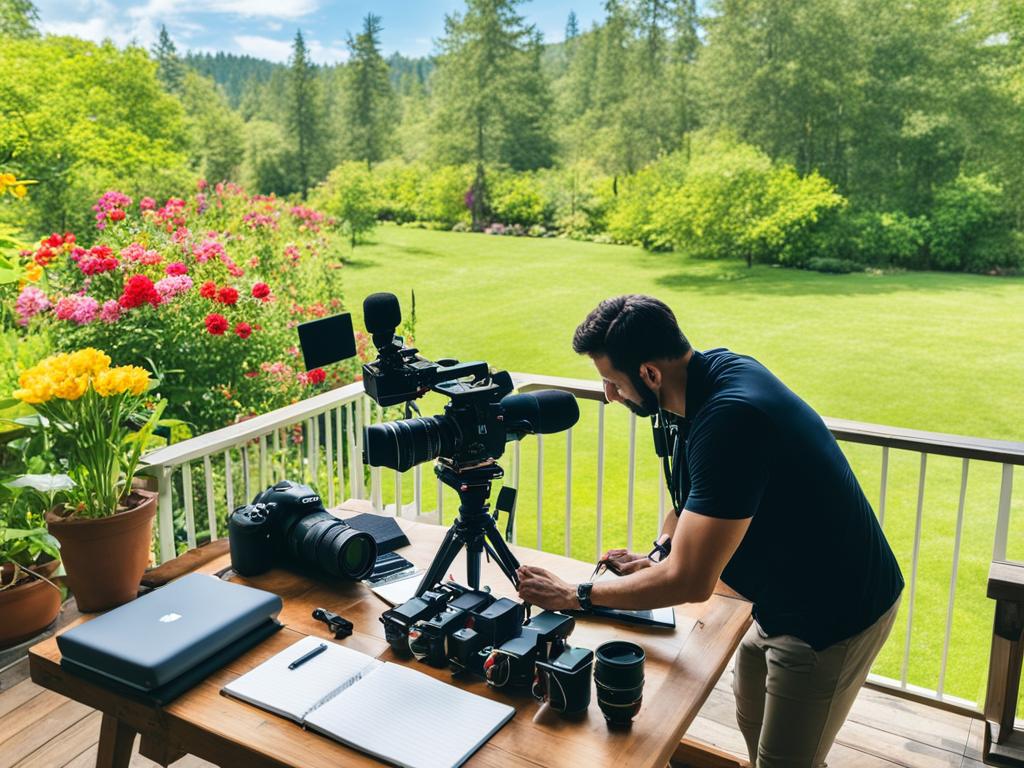
Conclusion
Real estate videography has become an essential tool for agents and sellers to captivate potential buyers and enhance property listings. By mastering the basics of real estate videography, understanding camera settings, employing effective shooting techniques, and utilizing post-production editing, agents can create compelling videos that generate and nurture leads.
Investing in high-quality cameras and exploring real estate video courses can further enhance the effectiveness of real estate videography. By staying updated with the latest equipment and techniques, agents can produce high-quality videos that stand out in the competitive real estate market.
Utilizing different video types can also make a significant impact. From educational videos that provide valuable information to potential buyers, to listing walk-through videos that highlight the best features of a property, each video has its unique role in attracting and engaging buyers. By integrating a variety of video types into their marketing strategies, agents can create a diverse and engaging portfolio of real estate videos.
With the right strategy and techniques, real estate videos can significantly impact sales and buyer engagement. By creating visually appealing and immersive videos, agents can showcase properties in the most compelling way, attracting more potential buyers and increasing the chances of closing deals in the competitive real estate market.
FAQ
What are the key camera settings for real estate videography?
The key camera settings for real estate videography include resolution, white balance, frame rate, shutter speed, ISO, aperture, and picture profile.
How should I prepare before shooting a real estate video?
Before shooting a real estate video, it’s important to communicate with clients to understand their preferences and highlight specific features. Additionally, familiarize yourself with the neighborhood and gather knowledge about nearby amenities and attractions.
What shooting techniques should I use for real estate videography?
Effective shooting techniques for real estate videography include capturing multiple angles, emphasizing spaciousness by standing in corners, capturing exterior shots, and utilizing drone footage.
What is involved in the post-production editing process for real estate videos?
The post-production editing process for real estate videos involves selecting the best clips, making lighting adjustments, color correction, noise removal, and embedding appropriate music.
What are the benefits of real estate video marketing?
Real estate video marketing can enhance buyer engagement, increase online presence, provide an immersive experience for potential buyers, and attract more potential buyers to property listings.
How much does real estate videography cost?
The cost of real estate videography can vary depending on factors such as property value and the videographer’s expertise. Professional videographers may charge up to $2,500 for an above-average house.
What are some recommended cameras for real estate videography?
Some recommended cameras for real estate videography include the Canon EOS 1D X Mark, Sony Alpha, and Panasonic Lumix FZ80.
Is it advisable to shoot real estate videos in different weather conditions?
Yes, shooting real estate videos in different weather conditions, such as cloudy or rainy weather, can add a unique atmosphere and highlight certain features of the property.
Are there any online courses for learning real estate videography?
Yes, there are several online courses available for learning real estate videography, including Real Estate Video Pro by Full Time Filmmaker, Tomorrow’s Filmmakers, and Skillshare.
What are some effective types of real estate videos for generating and nurturing leads?
Some effective types of real estate videos for generating and nurturing leads include educational videos, listing walk-through videos, agent introduction videos, and client testimonial videos.
What are some tips for creating irresistible real estate videos?
Some tips for creating irresistible real estate videos include investing in high-quality audio equipment, creating engaging and informative content, focusing on visual appeal with proper lighting and editing techniques, and optimizing video thumbnails.

